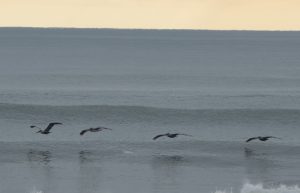
By Les Harrison
Living in Wakulla County has a variety of exceptional benefits. The natural environment is a feature visitors travel great distances to experience and enjoy during their leisure periods.
While some residents may take this advantage for granted after a while, a short stopover to another part of the state or country helps put this quality of life issue in clear perspective. Life here is hard to beat
Another plus is the fresh local seafood, and more than the human residents appreciate it. Brown pelicans patrol the coastal waters daily as they have for centuries in search of watery delicacies.
The pelican’s gaping mouth is augmented by a pouch suspended from the lower half of the bird’s long, straight bill. The bill may compose one-third of the birds overall length.
Brown pelicans are a common sight skimming a few inches above the placid waters of bays, inlets and brackish backwaters. Keen eyesight and sharp reflexes allow these birds to spot small fish and other sea creatures near the surface.
When their target is identified, they plunge headfirst with the mouth open at the prospective target. The pouch functions as a dip-net, trapping the startled fish.
The pouch holds the pelican’s catch until the water, up to three gallons, is squeezed out. After a successful dive, laughing gulls may hover near the pelican ready to steal any fish within easy reach.
The multi-purpose pouch serves as more than a dip-net. It also serves as a cooling system during hot weather, and as a feeding trough for young pelicans.
The brown pelican are sometimes referred to in literature as the American brown pelican or the common pelican. Whatever name is used, they populate the Atlantic, Pacific, and Gulf Coasts of North and South America.
It is the most frequently seen pelican in this range, but the smallest member at 54 inches in length. They are easily identified by their chestnut and white necks, white heads with pale yellow crowns, brown-streaked back and tail, and gray bill and pouch.
Their 6 1/2- to 7 1/2-foot wingspan easily support the ten pound adult weight in flight. Airborne their necks are folded with heads resting on their backs as they employ a steady powerful wing beat to propel them in search of fish.
Brown pelicans are powerful and agile swimmers. Their young are at home and functioning in the water even as they are still learning to fly.
On land their appearance is awkward and clumsy. Large flocks of pelicans collect on land and in the water during much of the year for gregarious social interaction.
Wakulla County’s brown pelicans are mainly fish eaters which require up to four pounds of fish daily to support a healthy active adult bird. Their diet consists primarily of fish under a foot in length, and not commercially significant. The occasional shrimp will find its way into the pelican pouch, too.
The living is good in Wakulla County, even the pelicans agree.
To learn more about the brown pelican and its importance, visit the UF/IFAS Wakulla County website at https://blogs.ifas.ufl.edu/wakullaco or call 850-926-3931.
 0
0
